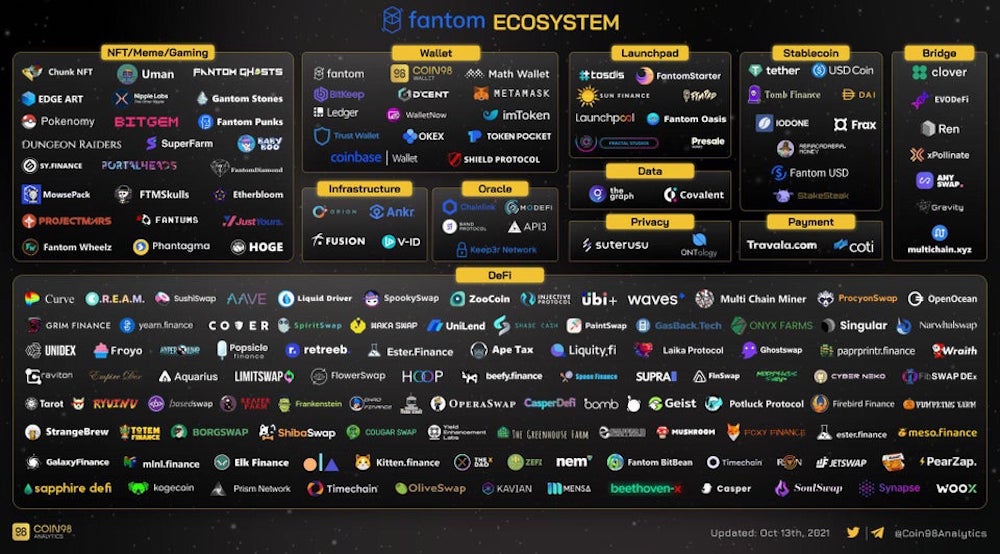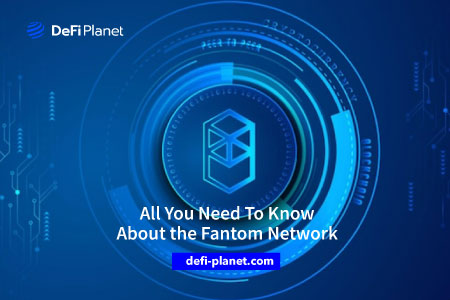Despite the declining value of Bitcoin and the prolonged bear crypto market, Fantom- a next-generation blockchain platform- continues to dominate the spotlight and outperforms other early blockchain-based cryptocurrencies.
Fantom is a highly scalable and fast solution for securing consensus algorithms and cross-platform interaction capabilities for blockchain developers and decentralized applications (dApps).
This article explores the Fantom network, how it works, and its benefits, among other things.
What is Fantom?
Fantom is a distributed ledger technology stack developing a platform based on a directed acyclic graph (DAG) that can power smart cities and their services.
Unlike blockchains, which are made up of blocks with vertices and edges, a DAG is a data modeling tool used in cryptocurrencies. These transactions are recorded against one another. In essence, this program makes it possible for blockchains to perform more complex transactions than simply exchanging cryptocurrency.

Decentralized finance (DeFi) requires a platform with extremely high speed and performance, and developers have been able to build a large number of decentralized apps (dApps) that can power DeFi through smart contracts.
With a target of 300,000 transactions per second and cross-chain connectivity between providers, this concept has attracted a large number of investors.
The Fantom team envisions the platform being used in a variety of industries, such as smart home systems, resource management, and healthcare. As a result, the ecosystem continues to expand.
What Issues Does “Fantom” Solve?
Fantom was created to address most of the issues that developers and Ethereum users face.
The network’s primary goal is to build a scalable and secure decentralized network. In this regard, the development team has been relatively successful.
Fantom can provide instant transactions and practically limitless scalability at almost zero cost. Some of the issues that Fantom solves are highlighted below:
Energy Consumption
Fantom abandons the energy-intensive Proof-of-Work (PoW) consensus process employed by cryptocurrencies like Bitcoin and Ethereum.
With the help of this technique, the network can validate its status while consuming less energy. As a result, Fantom is more environmentally friendly and sustainable.
High Gas Fees
One of the most significant benefits of Fantom is its low fee structure.
Users can execute transactions for a fraction of the price that Ethereum currently charges.
This micro-fee method also benefits developers because it allows them to offer their services at a much lower cost.
What Makes Fantom (FTM) Unique?
Traditional blockchain systems, such as the Bitcoin blockchain, prioritize security and decentralization over scalability.
For example, a transaction on the Bitcoin network may take between 10 and 15 minutes to complete. This makes scaling the network in terms of transactions difficult.
The Fantom team hopes to close this gap by securing the network with a leaderless Proof-of-Stake (PoS) protocol. A transaction on the FTM network can also be completed in 1 to 2 seconds. Furthermore, unlike Bitcoin, transaction fees are much lower.
The Fantom Opera mainnet supports complete smart contract functionality with Solidity and is compatible with the Ethereum Virtual Machine (EVM). Fantom’s network is also unique due to its self-contained nature. This means that the performance of one network location’s traffic congestion does not affect other network locations.
Because of Fantom’s high level of scalability, each application receives its own blockchain with its own set of governance rules, tokens, and tokenomics.
Fantom is made up of an infinite number of separate systems that work independently but also interact with one another.
How ‘Fantom’ Works
If users want to learn about Fantom and its other components, they must focus on how the Fantom wallet works. Fantom, like other distributed ledger technologies, can be used to create decentralized platforms for a variety of use cases.
Fantom uses a directed acyclic graph, or DAG, instead of a blockchain. As a result, Fantom can guarantee greater flexibility and speed than its competitors using blockchain technology.
The high-level overview of how Fantom works would show how the FTM token can help different network users maintain network nodes.
Users could also pay the required commission to use the assets staked by Proof of Stake algorithm players. The FTM token can also be used for interparty financial transactions.
In addition to Fantom tokens, the new Layer 1 network implementation includes a few other components. By looking at Fantom’s technologies, you can get a good idea of how it works.
The Benefits of Fantom
Payments
Payments on Fantom are fast due to the network’s swift finality. Because of its high throughput and low fees (approximately $0.0000001), the FTM token is also ideal for money exchange.
Governance
FTM is required for on-chain governance, which allows stakeholders to vote on changes and advancements made through governance. Fantom’s permissionless and leaderless decentralized ecosystem means that the on-chain governance mechanism makes all network decisions. As a result, FTM holders must participate in the voting process.
Staking
FTM can be staked to protect the Fantom network and earn FTM tokens as a reward without needing specialized hardware or software. This can be done using a phone or a computer.
Network Fees
FTM is used to pay network fees such as those for establishing Fantom smart contracts, constructing new networks, and even transaction costs.
By charging a fee, spam and malicious users who would otherwise slow down the network or fill the ledger with useless data are kept at bay.
Even though Fantom’s costs are very low, they are sufficient to deter attackers by making it prohibitively expensive for them to enter the system.
Security
The FTM token safeguards the network through a Proof-of-Stake (PoS) consensus mechanism in which stakers need to lock their tokens, and validators must have at least 3,175,000 FTM to participate. Stakers and validators are compensated with epoch rewards and fees for their services.
Fantom DeFi
Fantom is a state-of-the-art DeFi suite for every user, demonstrating the adaptability of the Fantom ecosystem. DeFi’s EVM-compliant smart contracts allow it to run flawlessly on Fantom.
Liquid Staking
This involves using staked FTM coins as security for DeFi applications. Every asset in the ecosystem is liquid.
Geist Finance is a popular DeFi protocol. Geist has a larger market capitalization than several small, controlled exchanges. With two security audits and 50% of platform costs going to consumers, it’s easy to see why this protocol has gained traction.
fMint
Users can create dozens of synthetic assets on Fantom, such as cryptocurrencies, fiat currencies, and commodities. They can also be created using different protocols and then converted to fMint by claiming from liquid staking.
fLend
It allows lending and borrowing digital assets for trading and interest-earning without compromising the user’s Fantom exposure.
fTrade
This is a non-custodial, decentralized AMM exchange that operates entirely within the wallet. SpookySwap is a popular example (a platform with an appealing UI).
Where Can You Buy Fantom?
Fantom ($FTM) can currently be purchased on the following exchanges:
Bitstamp
Bitstamp, established in 2011, is one of the world’s oldest and most reputable exchanges. It is operational in the United Kingdom, Canada, and the United States but not for residents of Hawaii, Nevada, Alabama, Louisiana, Idaho, or New Jersey.
Uphold
Uphold is one of the best exchanges for residents of the United States and the United Kingdom because it offers a wide range of cryptocurrencies. The platform is not licensed to operate in the Netherlands and Germany.
Binance
Binance is arguably the largest crypto exchange in the world, and it is operational in several countries, including Australia, the United Kingdom, Indonesia, Germany, Spain, Norway, Poland, Portugal, and Canada. Residents of the United States can only access a limited number of tokens on the exchange.
KuCoin
KuCoin currently supports trading over 600 popular cryptocurrencies and more than 1,000 cryptocurrency pairs.
As of the start of 2022, KuCoin has more than 10 million registered users in over 200 countries. It frequently offers listing and purchasing opportunities for new tokens. The exchange is now available to residents of the United States and several other countries.
In Conclusion,
- Fantom is a novel protocol that solves scalability issues using DAG technology. This network’s main competitors are IOTA (which launched in 2015 and was one of the first DAG projects) and HBAR (which uses smart contracts in the same way as Fantom).
- Fantom may be a wise investment given its fast transaction speeds, zero-network failure condition, and powerful smart contract platform. Although the price has dropped since its record high, it still has a small market cap compared to its competitors.
- Although enterprise adoption is the primary goal and focus of many blockchain initiatives, it is unclear how widely Fantom will be adopted.
- Always conduct due diligence before investing in cryptocurrencies.
Disclaimer: This article is intended solely for informational purposes and should not be considered trading or investment advice. Nothing herein should be construed as financial, legal, or tax advice. Trading or investing in cryptocurrencies carries a considerable risk of financial loss. Always conduct due diligence.
If you would like to read more articles like this, visit DeFi Planet and follow us on Twitter, LinkedIn, Facebook, and Instagram.
“Take control of your crypto portfolio with MARKETS PRO, DeFi Planet’s suite of analytics tools.”





















